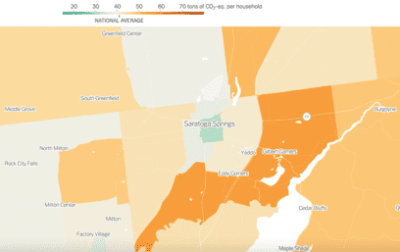
By Kate Phillips
On December 13, 2022, The New York Times published an article with a map that shows the 2017 carbon footprint of every neighborhood in the United States, assessed by the carbon dioxide generated per household and color-coded by its relationship to the national average. The Times produced the map based on UC Berkeley research, which finds patterns in carbon-generation across America. For example, homes in dense neighborhoods or cities generate more carbon than those in the suburbs or rural areas, and wealthy households often contribute more carbon than low-income households.

Saratoga Springs’ carbon footprint is below the national average and smaller than surrounding areas. However, Saratoga generated about 30 tons of carbon per household in 2017, and residents should reduce their carbon footprint to mitigate climate change. In light of the New York Times article, Sustainable Saratoga has created a guide to reducing your carbon footprint.
How to Start
Calculating your carbon footprint is a constructive place to start your journey to a more sustainable life. You can use the CURE100 carbon tracker to help. The calculator asks you about carbon generation in your house, various types of transportation, and secondary consumption (food, clothing, etc.) The results break down your carbon footprint in each of the categories. You can use the calculator to identify how much carbon you generate and where you can reduce that footprint.
Below, Sustainable Saratoga provides advice for tackling your carbon generation. Not every suggestion will work for every household, so think about how you and those you live with can best adapt to a sustainable lifestyle.
Shopping
An effective option for reducing your footprint is to buy less. Some strategies for preventing overconsumption include meal planning for the week to avoid wasting food or buying clothes you will re-wear.
 However, there are also ways to reduce your footprint while having a great shopping day. One of my favorite options is thrift shopping. Clothing – especially fast-fashion items – has a huge carbon footprint. From water usage to transportation, popular brand items require copious amounts of carbon. Not-so-fun fact: According to the BBC, 8-10% of global carbon emissions are generated by the fast fashion industry. Thrift shopping is a great way to reduce your carbon footprint and is often a cost-saver. Or try getting used items for free on one of the local gifting sites.
However, there are also ways to reduce your footprint while having a great shopping day. One of my favorite options is thrift shopping. Clothing – especially fast-fashion items – has a huge carbon footprint. From water usage to transportation, popular brand items require copious amounts of carbon. Not-so-fun fact: According to the BBC, 8-10% of global carbon emissions are generated by the fast fashion industry. Thrift shopping is a great way to reduce your carbon footprint and is often a cost-saver. Or try getting used items for free on one of the local gifting sites.
In general, do your best to shop at businesses that focus on sustainable practices. Some companies are more environmentally conscious than others, and it is great to shop from vendors doing their part to reduce their carbon footprint. Search for stores and products that are sustainably produced to feel great about your purchases!
Food
Avoiding a carbon footprint in your food purchasing is impossible, as the entire food production process is carbon-heavy. However, you can take steps to buy more sustainable food. One option is to eat organic and local food. Organic food requires fewer chemicals, so organic products are safer for you and the land where it is grown. Buying local food is also a good option because the transportation emissions for local products are lesser than those for food shipped across the country or world. Saratoga has two producers-only farmers markets: Saratoga Farmers Market on Saturdays and Spa City Farmers market on Sundays. It’s a great opportunity to support local vendors!
You can also reduce your carbon footprint at the grocery store by purchasing items that have minimal plastic packaging. Items with plastic packaging add to your carbon footprint because most plastic is produced by fossil fuels. One great way to decrease your plastic consumption is to purchase a big box of your snack of choice rather than small, individually wrapped bags. Also, invest in a few metal straws and reusable water bottles. Reusing straws and water bottles will decrease your carbon footprint, and keep plastic out of the landfill and ocean.
Once you leave the store, you can decrease your carbon footprint at home by composting. From banana peels to coffee grounds, we all throw away food. Composting is a fantastic way to reduce your footprint and feel less guilty about your moldy fruit. You can dispose of compost in your backyard or join a composting program. Read Sustainable Saratoga’s Composting Opportunities for more options.
Lastly, try to eat less dairy and meat. Both industries use excessive amounts of water and fuel to make their products. Many people worry that their protein intake will take a hit if they stop eating meat, but there are great ways to get nutrition while eating vegetarian meals. Beans, tofu, and tempeh are excellent protein sources, and there are many types of plant-based milk. If you don’t trust me, take it from football superstar Tom Brady – 80% of his diet is plant-based food!
Everyday Chores and Activities
There are sustainable choices you can make around the house. One of the offenders that contribute to a household’s carbon footprint is water use. Many people love a long, hot shower, but unfortunately, they significantly increase your carbon footprint. Try taking a shorter shower, and turn down the heat. Another method of saving water is doing less laundry and hanging your clothes to dry. While this extra step may be a bit inconvenient, you will reduce water and energy use, and air-drying your clothes causes them to shrink less and last longer.
Reducing your time in the car is another effective way to reduce your daily carbon footprint. Gas-powered cars have a very high carbon footprint, and while the rise in electric vehicles is a step in the right direction, many EVs use energy produced by fossil fuels, so they still have a high carbon footprint. Try to use public transportation, carpool, bike, or walk. Public transportation is convenient in Saratoga, and the CDTA is a great option when traveling locally. If you are going somewhere in a group, you can also carpool to reduce emissions. And, for zero-carbon transportation, biking or walking is highly encouraged. Saratoga Springs has some beautiful bike and running paths.
Reuse, then Recycle
Finally, learn about Saratoga Springs’ recycling. Remember: Reusing an item is always better than recycling. Before you throw something in the recycling bin, ask yourself: how could I use this again? Our Donation and Recycling Guide is packed with information on what to do with your unwanted items. When you do need to recycle a product, keep in mind that recycling in America is run by municipalities rather than states or the federal government. Consequently, each town and city is uniquely equipped to handle different types of plastic. Just because a plastic product has a triangle with arrows does NOT mean you can recycle it. Check out the Saratoga Springs transfer station site to discover what products you can recycle. Sustainable Saratoga also has a recycling guide and recycling brochure to help you out. It’s imperative to throw away or reuse plastic that is not recyclable in your municipality because it can contaminate recyclable products. Here are a few key points about recycling in Saratoga:
- Plastic with numbers 1-7 can be recycled
- Items with excessive food waste must be thrown away
- No styrofoam may be recycled
 Electronic waste can be more difficult to recycle than paper and plastic, but it is still crucial. To recycle e-waste, you can go to any of these locations in the Saratoga area. Also, try fixing your current device before buying a new one. Sustainable Saratoga and the Saratoga Public Library host free Repair Café events where you can bring in broken objects for repair. It is often cheaper and much better for the environment. Using your electronics takes up a lot of energy, but there are simple ways to reduce your digital footprint. Try cleaning out your cloud storage when it gets full – you will save energy, and maybe some money. You can also delete old emails and unsubscribe from email lists you don’t need, as every email you send and hold on to generates more energy.
Electronic waste can be more difficult to recycle than paper and plastic, but it is still crucial. To recycle e-waste, you can go to any of these locations in the Saratoga area. Also, try fixing your current device before buying a new one. Sustainable Saratoga and the Saratoga Public Library host free Repair Café events where you can bring in broken objects for repair. It is often cheaper and much better for the environment. Using your electronics takes up a lot of energy, but there are simple ways to reduce your digital footprint. Try cleaning out your cloud storage when it gets full – you will save energy, and maybe some money. You can also delete old emails and unsubscribe from email lists you don’t need, as every email you send and hold on to generates more energy.
Plastic-Free Wrap Up
Reducing your carbon footprint can feel overwhelming, but you will be doing a huge favor to your environment and community. Start by implementing some of these options that best fit your lifestyle.
- Buy less
- Thrift shop
- Minimize plastic packaging consumption
- Shop at sustainable businesses
- Eat organic and local food
- Use reusable water bottles
- Compost
- Eat less dairy and meat
- Use less water
- Drive less
- Learn about local recycling
Resources
Sustainable Saratoga’s Donation and Recycling Guide
Sustainable Saratoga’s Composting Resources
The 35 easiest ways to reduce your carbon footprint (Columbia Climate School)
How to reduce your carbon footprint (UNC Chapel Hill)





